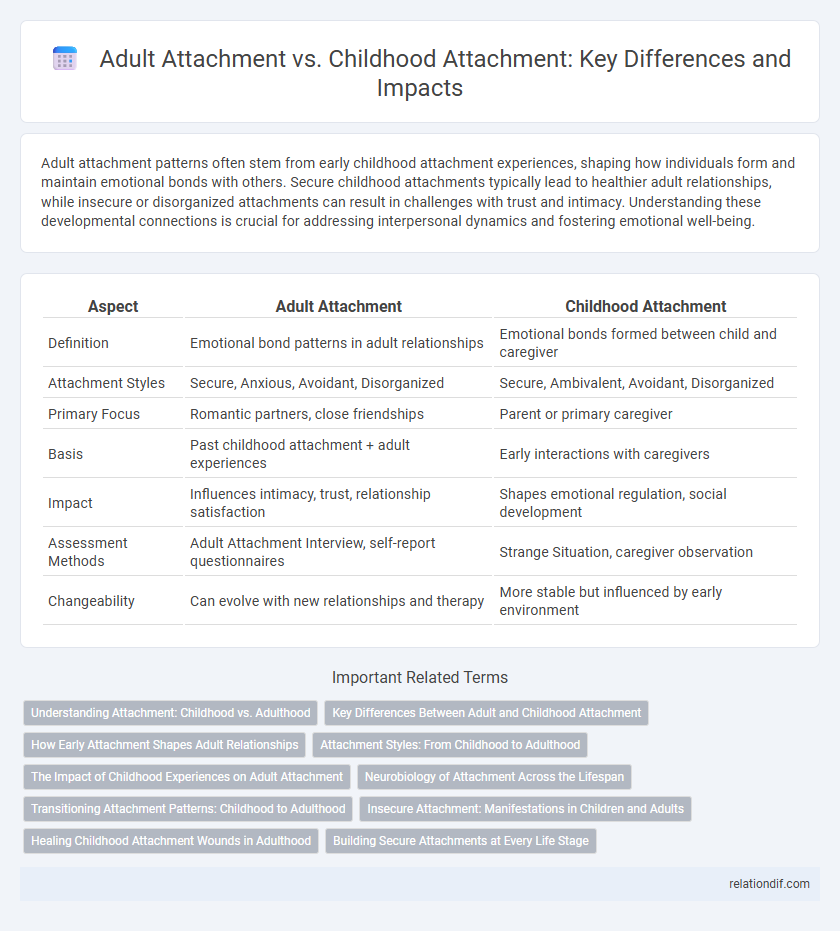Adult attachment patterns often stem from early childhood attachment experiences, shaping how individuals form and maintain emotional bonds with others. Secure childhood attachments typically lead to healthier adult relationships, while insecure or disorganized attachments can result in challenges with trust and intimacy. Understanding these developmental connections is crucial for addressing interpersonal dynamics and fostering emotional well-being.
Table of Comparison
| Aspect | Adult Attachment | Childhood Attachment |
|---|---|---|
| Definition | Emotional bond patterns in adult relationships | Emotional bonds formed between child and caregiver |
| Attachment Styles | Secure, Anxious, Avoidant, Disorganized | Secure, Ambivalent, Avoidant, Disorganized |
| Primary Focus | Romantic partners, close friendships | Parent or primary caregiver |
| Basis | Past childhood attachment + adult experiences | Early interactions with caregivers |
| Impact | Influences intimacy, trust, relationship satisfaction | Shapes emotional regulation, social development |
| Assessment Methods | Adult Attachment Interview, self-report questionnaires | Strange Situation, caregiver observation |
| Changeability | Can evolve with new relationships and therapy | More stable but influenced by early environment |
Understanding Attachment: Childhood vs. Adulthood
Childhood attachment forms the foundation of emotional security, primarily shaped by early caregiver interactions that influence trust and safety perceptions. Adult attachment patterns, while rooted in these formative experiences, evolve to encompass romantic relationships and social bonds, reflecting more complex emotional regulation and intimacy needs. Understanding attachment differences highlights that secure childhood attachments typically foster healthier adult relationships, whereas unresolved childhood insecurities often manifest as anxious or avoidant attachment styles in adulthood.
Key Differences Between Adult and Childhood Attachment
Adult attachment patterns reflect complex emotional regulation and relationship dynamics shaped by early experiences, whereas childhood attachment primarily centers on dependence and security with primary caregivers. Key differences include the development of internal working models in adulthood, influencing romantic and social bonds, contrasted with the foundational survival-based attachment behaviors observed in childhood. Adult attachment styles--secure, anxious, avoidant, and disorganized--are extensions of childhood attachment patterns but are modulated by cognitive maturity and social experiences.
How Early Attachment Shapes Adult Relationships
Early attachment experiences with primary caregivers create internal working models that guide expectations and behaviors in adult relationships. Secure childhood attachments foster emotional regulation, trust, and intimacy, whereas insecure attachments may lead to difficulties in forming stable adult bonds. Neuroscientific studies reveal that these early patterns influence brain development in areas responsible for emotional processing and social connection throughout adulthood.
Attachment Styles: From Childhood to Adulthood
Attachment styles formed in childhood, such as secure, anxious, avoidant, and disorganized, critically influence adult relational patterns and emotional regulation. Early interactions with caregivers shape internal working models that predict adult attachment behaviors in romantic and social relationships. Understanding these developmental continuities aids in therapeutic interventions aimed at resolving attachment-related challenges across the lifespan.
The Impact of Childhood Experiences on Adult Attachment
Childhood attachment experiences shape adult attachment styles by influencing emotional regulation and relationship expectations. Secure attachments formed in early years often lead to healthier adult relationships, while adverse childhood experiences like neglect or inconsistency increase the likelihood of anxious or avoidant attachment patterns. Understanding the continuity between childhood and adult attachment aids in developing targeted therapeutic interventions for relational difficulties.
Neurobiology of Attachment Across the Lifespan
Adult attachment patterns are profoundly influenced by early childhood attachment experiences, with neurobiological mechanisms involving the oxytocin system, amygdala, and prefrontal cortex playing critical roles in emotional regulation and social bonding. During childhood, secure attachments promote optimal development of neural circuits related to stress response and empathy, while insecure attachments can lead to heightened amygdala reactivity and altered hypothalamic-pituitary-adrenal (HPA) axis function. Neuroplasticity across the lifespan allows adult attachment representations to be reshaped through relational experiences, impacting long-term mental health and interpersonal functioning.
Transitioning Attachment Patterns: Childhood to Adulthood
Transitioning attachment patterns from childhood to adulthood involve the evolution of early attachment styles formed with primary caregivers into more complex relational dynamics. Secure, avoidant, anxious, or disorganized attachments established in childhood often influence adult romantic relationships, emotional regulation, and interpersonal trust. Neurobiological and environmental factors contribute to modifying these patterns, allowing potential for attachment security development or perpetuation of maladaptive behaviors.
Insecure Attachment: Manifestations in Children and Adults
Insecure attachment in childhood often manifests through anxiety, avoidance, and difficulty trusting caregivers, leading to emotional dysregulation and social challenges. Adults with insecure attachment may exhibit relationship instability, fear of abandonment, and impaired emotional intimacy, reflecting patterns rooted in early attachment experiences. Understanding the continuity of insecure attachment highlights the importance of therapeutic interventions that address both childhood trauma and adult relational difficulties.
Healing Childhood Attachment Wounds in Adulthood
Healing childhood attachment wounds in adulthood requires recognizing and understanding the deep-rooted patterns formed during early relationships with caregivers. Therapeutic approaches such as somatic experiencing, cognitive-behavioral therapy, and emotionally focused therapy are effective in reframing attachment schemas and fostering secure adult attachments. Consistent emotional support, self-awareness, and building trust in current relationships are critical factors in repairing attachment injuries and promoting emotional resilience.
Building Secure Attachments at Every Life Stage
Adult attachment patterns are deeply influenced by childhood attachment experiences, shaping emotional regulation and relationship satisfaction. Building secure attachments throughout life involves consistent responsiveness, trust-building, and emotional attunement in relationships. Interventions like therapy and mindfulness can help individuals rewire insecure attachment patterns to foster healthier adult connections.
Adult attachment vs childhood attachment Infographic

 relationdif.com
relationdif.com